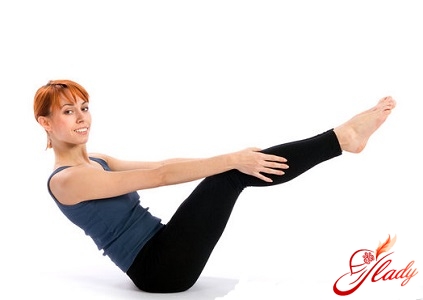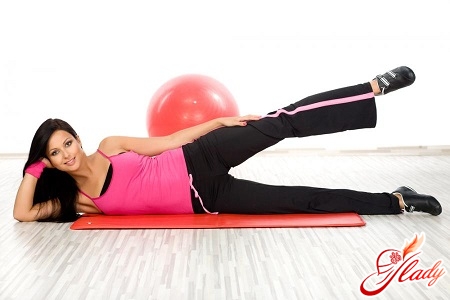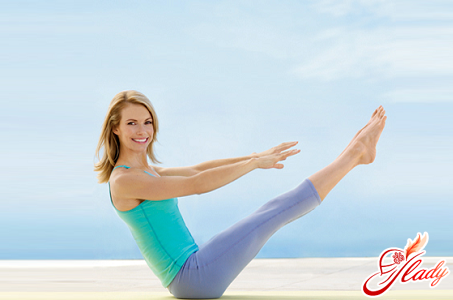 Gymnastics in the early postpartum periodreally helps the recovery process. It is only important to observe the rate of increase in load and variety of exercises. The same exercises and boring, monotonous training, on the contrary, can cause a reaction opposite to the expected one. We advise you to do fitness before and after childbirth, then your figure will always be in perfect condition. Visiting
Gymnastics in the early postpartum periodreally helps the recovery process. It is only important to observe the rate of increase in load and variety of exercises. The same exercises and boring, monotonous training, on the contrary, can cause a reaction opposite to the expected one. We advise you to do fitness before and after childbirth, then your figure will always be in perfect condition. Visitingyou will be able to choose the type of training for yourself,that suits you, such as dancing and strength training, and a doctor - a nutritionist will tell you how to eat right without harming your health. If you do not have time to visit the gym, since you cannot yet leave your newborn child with a nanny, grandmother or dad, then you can do some exercises yourself at home. Below are 4 small sets of exercises for restorative gymnastics. Choose the set that you can do calmly and without overexertion. A few additional instructions:
- All these exercises remain relevant throughout the postpartum period, and not only in its early phase. They can and should be done within 10-12 weeks.
- It is best to start on the first day after childbirth.
- Exercise should be done regularly, several times a day, lying on a flat surface (take a small pillow for convenience).
- Move slowly, without concentrating, smoothly. In no case is it abrupt.
- The room where you are engaged should be well ventilated. The optimum temperature is 18-20 ° C.
- It is necessary to work in a comfortable, not constraining movement clothes.
- Do not forget to go to the toilet before training.
- To train better after feeding.
- Rise from the "lying" position always by turning over the side.
- Lying most of the time is better on the abdomen, thereby supporting the involution of the uterus and reducing postpartum discharge.
- Early retirement after childbirth and walking support recovery processes. Pay attention to the good setting of the feet and especially on the "rolling" from the heel to the toe.
Restorative gymnastics
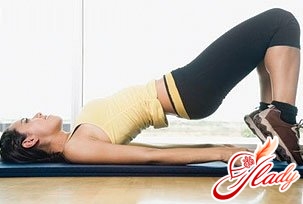
- 1st set of exercises
Exercises for the prevention of thrombosis.You can start doing exercises on the first day after giving birth. Starting position: lying on your back, both legs bent at the knees. Straighten your legs so that the sides of your knees do not come apart. Squeeze your toes (“pull your claws in”) 10 times slowly and strongly and lower them again. Straighten one leg. Pull your toe slowly and strongly toward you 10 times, and then back. Change legs. Do the previous exercises with both legs, without lifting them, but simply stretching out on your back. Addition: if you had varicose veins or leg pain during pregnancy, use special elastic gaiters or stockings.
- 2nd set of exercises
When doing these exercises, you need to breathe.lower abdomen. You can start doing exercises on the very first day after giving birth. Starting position: lying on your back, both legs bent at the knees. Place your hands on your lower abdomen. Inhale slowly through your nose and then exhale slowly through your mouth "haaaa". The abdomen rises during inhalation, then during exhalation, slightly help it with your hands, moving your palms in the direction from the pubic bone to the navel. Do not press, but simply stretch your hands along the lower abdomen. Then turn on your side. The head, chest and pelvis are in one line (you can use a small pillow or a bolster under the neck), knees are slightly bent. The upper hand lies on the lower abdomen. And again repeat the breathing exercises with the abdomen, stretching your hand from the pubic bone to the navel during exhalation (in fact, you move the pelvis forward, without bending the torso). To increase the tension even more, say "pfff" or "puuuh" as you exhale, while imagining that your stomach is being compressed like a sponge. Then turn over onto your stomach. Place a small, firm pillow under your lower abdomen. It is important that the pressure on your chest is minimal or absent altogether. Breathe with your lower abdomen. And again, as you exhale (on "haa", "pff" or "puh"), move your pelvis forward again.
- The third set of exercises
The main load of these exercises is aimed atmuscles of the perineum and pelvic floor, so be careful when doing the exercises, or move on to an easier set. One of the functions of the pelvic floor muscles is to support the internal organs: the uterus, bladder, intestines. During childbirth, the "retaining" muscles of the urethra, the entrance to the vagina and the rectum are greatly stretched. The sphincters weaken, and problems with control over urination and defecation begin. If an episiotomy (perineal incision) was performed during childbirth, it is advisable not to do this set of exercises until the suture heals, because the load can be very strong. In this case, it is advisable to do a set of "soft" exercises, lying on your stomach. Lying on a bed or sitting in a chair, try alternately straining the muscles of the vagina and anus. As if "blinking". At first, it may seem that alternate muscle contraction is impossible, but this is not so. Soon you will be able to separate the muscle tension. Once you have managed to separate the "blinking", try to use your muscles to conduct a "wave" from the anus to the pubic bone. This exercise is also an aid in the treatment and prevention of hemorrhoids. When doing the exercises, be sure to monitor the muscles of the mouth: the tongue, palate and lips should be relaxed. This will help you relax the perineum in response and make your breathing soft. It is better to do the next exercise half-sitting or sitting. Try to slowly, tensing the muscles of the perineum and pelvis, pass the wave from the bottom up, through the pubic bone to the navel, making a slow movement of the pelvis forward. Slowly up, and then freely back. At the same time, you need to breathe evenly, without holding your inhalations and exhalations. But please do not try to give your muscles an increased load. The exercises should be done easily, as if playfully.
- 4th set of exercises
It has breathing control and bottom loading.таза дополняются тренировками мышц живота. Обратите внимание — все упражнения делаются на выдохе и мягком напряжении мышц таза. Исходное положение: лежа на боку, голова, грудная клетка и таз лежат на одной линии. Колени согнуты. Одна рука согнута в локте и лежит под головой. Второй рукой упритесь в кровать на уровне пупка. Ладонь лучше всего сжать в кулак. На выдохе чуть-чуть приподнимите таз, упираясь на кулак. Повторите несколько раз, затем это упражнение сделайте лежа на другом боку. Исходное положение: лежа на спине, ноги согнуты в коленях. Носочки подтянуты вверх. Во время выдоха начинайте тянуться носками к себе, приподнимая обе руки поочередно к правой или левой стороне. Поднимать грудь или отрывать пятки от плоскости не нужно. Исходное положение: стоя на четвереньках (упражнение можно также выполнять в кровати). Голова, верхняя часть туловища и таз находятся на одной линии. Колени расставлены на небольшое расстояние. Во время выдоха втягивайте живот и усиливайте напряжение тем, что слегка приподнимаете левое колено и правую ладонь. Затем поменяйте «диагональ» (приподнимите уже правое колено и левую ладонь). Далее одно из самых «нудных» упражнений комплекса: стоя на четвереньках, стопы плоско лежат, на выдохе старайтесь как можно больше выпрямить колени, не сгибая спину, стараясь сохранить ее возможно прямой. Основная масса тела при этом упражнении будет давить на ладони и тыльную сторону стопы. Исходное положение: лежа на боку, колени согнуты. «Верхняя» рука лежит спокойно вдоль тела, «нижняя» — создает упор на плоскости. Во время выдоха подтягивайте живот и приподнимайте туловище. Затем упражнение повторите на другой стороне. Обратите внимание — с одной стороны живот будет выпирать больше, чем с другой, — это нормальная ситуация (зависит от внутриутробного развития ребенка). На той стороне, где «свисание» больше, — упражнение стоит выполнять чаще. Теперь упражнение на стабилизацию мышц живота и спины. Исходное положение: стать лицом к спине, ноги расставлены и слегка согнуты в коленях. Руки упираются в стену полными ладонями, локти также прижаты к стене. Во время выдоха мысленно переместите оба локтя к пупку. Потом измените упражнение: опять мысленно двигайте правым локтем и левым коленом друг к другу. Затем левым локтем и правым коленом. Никаких фактических движений совершать не нужно. Вернувшись домой с малышом, вы можете решить, что вам некогда заниматься физкультурой. Но достаточно несложные упражнения можно выполнять, когда вы меняете пеленки, перед кормлением ребенка или сочетания упражнения с игрой с ребенком. Прежде всего, проверьте, нет ли расхождения мышц живота (диастаза), мышц, которые проходят сверху вниз от грудной клетки к лобковой кости. Соединительная ткань между этими мышцами может отреагировать на напряжение во время беременности без боли и кровотечения, подобно застежке-молнии, которая раскрывается под нажимом. Такое расхождение предохраняет мышцы от чрезмерного напряжения. Это нормально, однако требует специального внимания и принятия мер для того, чтобы закрыть такое расхождение. Для того чтобы определить, есть расхождение мышц или нет, лягте на спину, согнув ноги в коленях. Надавите пальцами одной руки в области живота, сразу над пупком (пальцы должны быть соединены вместе и расположены горизонтально). Начинайте медленно поднимать голову и плечи от кровати или от пола. Прямые мышцы живота напрягутся, позволяя обнаружить любое расхождение. Небольшое расхождение (шириной в один-два пальца, соединенных вместе) указывает на то, что вам нужно провести некоторую предварительную работу, прежде чем вы начнете делать интенсивные упражнения для мышц живота. Энергичные упражнения при наличии широкого расхождения будут только увеличивать расхождение и сделают их бессмысленными. Для того чтобы закрыть расхождение мышц живота, начните со следующего упражнения. Когда расхождение сузится до ширины в один-два пальца, приступайте к скольжению ног и диагональным или центральным подъемам-опусканиям из положения лежа на спине.
Simple exercises at home

- Exercises with lifting of the head
Lie on your back, bend your knees, and use your handsCross your arms around your stomach, placing your hands on your waist. Inhale. After exhaling, begin to lift your head off the bed or floor. At the same time, try to pull your straight muscles to the middle of your stomach with your hands. Slowly count to five. Slowly lower your head. Repeat the exercise 5 times 3-4 times a day.
- Exercises to reduce the muscles of the pelvic floor
This exercise can be started immediately after birth.Gently tighten and then relax the perineal muscles. This exercise can be done lying down, sitting, or standing. You may not feel the contractions, but if you did this exercise before giving birth, you know how to do it now. Start by doing two or three contractions every hour for the first few hours, then increase to five contractions several times a day. At first, you will only be able to hold the contraction for 2-3 seconds. After a few days - for 3-5 seconds. Gradually, your muscle endurance will increase to 10, then 20 seconds. To check if you are making progress with these exercises, try doing this exercise while urinating sometime - when your bladder is half empty, try to stop the flow. Do not be discouraged if you cannot do this at first. Keep practicing. Test the strength and endurance of your pelvic floor muscles as described above - interrupting the flow of urine in the middle of urination.
- Pelvic Deflection
This exercise will help to increase tone and strength.abdominal muscles, relieve lower back pain, maintain good posture. Start doing the following exercise soon after giving birth. Lie on your back on the bed or on the floor, bend your knees. Tighten your abdominal muscles and arch your pelvis, then return to the starting position. Do the exercise two or three times. Gradually increase the number of exercises to five. After a few days, start doing pelvic rotations in a standing or sitting position. This exercise helps strengthen the muscles of the lower abdomen. Lie on your back, bend your knees, and place your feet on the floor. Your legs will slide better if you do the exercise in socks or stockings. Place one or both hands under your lower back. Slowly begin to stretch your legs, sliding your feet along the floor until you feel your lower back lift off your hands or the floor. At this point, stop sliding and pull your legs up, returning to the starting position. Repeat this exercise five times a day. Remember that you only need to do the exercise until your lower back lifts off the floor. When the muscles get stronger, you will be able to straighten your legs completely without lifting your lower back off the floor.
- Tilting back from the sitting position
A week or two after giving birth, startperform an exercise that will help strengthen the abdominal muscles. This exercise, as well as the central and diagonal raises (described below), are safer and more effective than squats, which require abrupt movements and lead to irrational overstraining of the lower back and abdominal muscles. The exercise "Leaning Back from a Seated Position" is smoother and safer, since the tension is distributed mainly to the pelvic area, and you do not have to overcome the force of gravity at the beginning of the exercise. Sit with your knees bent, feet pressed to the floor, arms extended in front of you. Slowly lean back, but only until you feel weak or begin to lose control of your posture. In other words, when you begin to feel unsteady or weak - you have reached your limit. Sit up and straighten up. Gradually, as your strength and endurance builds, increase the leaning back. Soon you will be able to straighten your back and touch the floor without lifting your feet off the floor. Make the exercise more difficult. Do bends with your arms crossed over your chest. Later, try doing this exercise with your clasped hands behind your head.
- Central and Diagonal Rises
This exercise also helps to strengthen muscles.abdominal press. Central lifts. Lie on your back with your knees bent and your feet flat on the floor. Inhale, arch your back, pressing your lower back to the floor. As you exhale, lift your head and shoulders off the floor, touching your knees with your fingertips. The movements should be smooth, with your lower back pressed to the floor. When your shoulders rise 20 cm above the floor, hold this position and slowly count to five. Relax and lie down gently on the floor. Do not make any sudden movements. In the beginning, repeat this exercise five times a day. Diagonal lifts. By rotating your upper body and simultaneously lifting your head and shoulders, you can strengthen various abdominal muscles (oblique muscles). Just like with central lifts, do not forget about breathing and straightening your back from the very beginning. As you exhale, lift your upper body in a left-hand rotation and touch the outside of your left knee. Hold and count slowly to five. Repeat the exercise with the torso rotated to the right. Perform the exercise five times a day in each direction. The movements of the central and diagonal lifts should be smooth, not jerky. As your abdominal muscles strengthen, the central and diagonal lifts can be made more difficult by doing them with your arms crossed over your chest or with your hands behind your head. Gradually increase the number of repetitions from five to ten per day.
- Wide circles with hands
This exercise helps to improve blood circulation.in the mammary glands and prevent or relieve blockages in the milk ducts. From a standing, kneeling, or sitting position, extend your arms forward or out to the sides. Rotate both arms in wide circles, first in one direction, then in the other. Try holding your breath while doing this exercise. Do five to ten exercises in each direction, one or more times a day or before each meal.
- Relaxation and slow breathing
Since the postpartum period is intensestress on the body, it is advisable to use the same relaxation technique that you used during pregnancy and childbirth. On difficult days, try breathing slowly and passively relaxing for 5 minutes and notice how much it invigorates and refreshes you. This technique is also useful for pain that occurs during feeding and at other times, especially for women who have had more than one child.
Exercises with the child
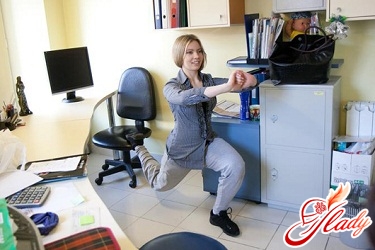 These exercises can be fun for both you and your baby. They combine playing with your baby and increasing overall tone in your stomach, arms, legs, and buttocks.
These exercises can be fun for both you and your baby. They combine playing with your baby and increasing overall tone in your stomach, arms, legs, and buttocks.
- Up and down (strengthening the tone of the hands)
Starting position.Lie on your back with your knees bent and your feet flat on the floor. Place your baby face down on your chest, holding him or her with your hands. Slowly and smoothly lift the baby up, then slowly place him or her on your chest. Repeat five times.
- "Twist" ("hanging on the hips")
Starting position: Sit on the floor with your legs extended.Hold the baby on your hips, supporting his head and shoulders with your hands. "Walk" - move forward on your buttocks, wriggling as you move, then move back. Repeat four or five times.
- Swing (central rises)
Starting position.Lie on your back with your hips and knees bent and your shins parallel to the floor. Place your baby face down on your shins, looking over your knees. Hold him with your hands. With your chin tucked to your chest, slowly lift your head and shoulders and rock forward (this is like a gentle midsection lift). Then return to the starting position and lower your head to the floor. Avoid holding your breath. Repeat five times.
- Rotation (sitting)
Starting position.Sit on the floor with your knees bent and your feet flat on the floor. Hold the baby against your chest or place him or her on your thighs. Slowly lean your back back, as you did in the sit-up exercises. Turn your back half a turn and return to the starting position. Gradually increase the number of repetitions to five times. We recommend reading:





